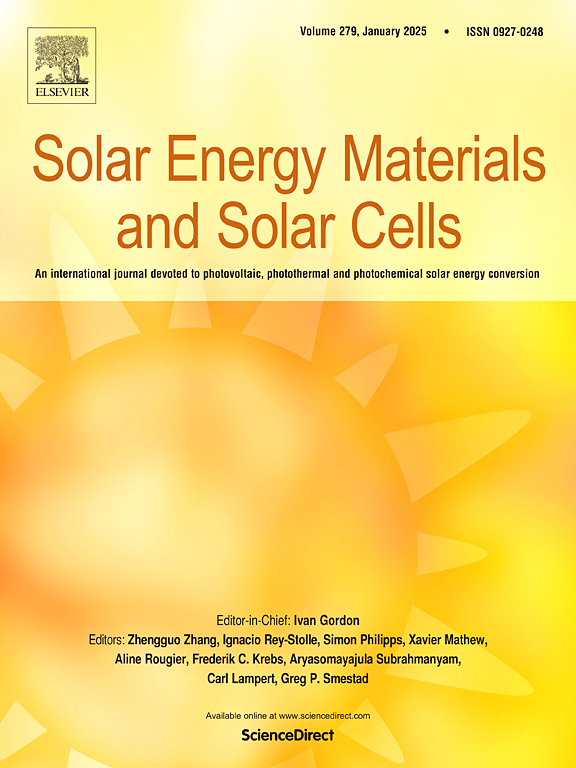垂直排列的双相Cu2O/Cu4O3异质结用于增强电荷提取和广谱太阳能转换
IF 6.3
2区 材料科学
Q2 ENERGY & FUELS
引用次数: 0
摘要
氧化亚铜(Cu2O)由于其直接带隙(2.1 ~ 2.5 eV)、丰度和环境友好性,是一种很有前途的用于太阳能转换的p型半导体。然而,传统的cu2o基太阳能电池通常基于单相结构,由于光吸收波长范围和载流子输运长度的限制,它们的转换效率仍然远远低于20%的理论极限。本研究提出了一种在可控氧通量调制下,通过反应磁控溅射精确制备垂直排列双相Cu2O/Cu4O3太阳能电池的策略。结果表明,在Cu2O/Cu4O3体系中,原子锋利的相界面和垂直有序的纳米结构促进了连续的载流子输运途径,有效地抑制了晶界处的重组损失,从而使载流子收集效率提高了22%。此外,在Cu2O/Cu4O3异质结处的- II型交错带对实现了互补的带隙协同作用,将光响应阈值从518 nm扩展到623 nm,提高了53%的光吸收率,最终产生1.06%的功率转换效率,比单相Cu2O器件提高了193%。我们的工作建立了垂直有序纳米复合材料的通用设计范例,推进了高性能氧化铜光伏的发展,并为更广泛的光电和人工光合作用系统提供了见解。本文章由计算机程序翻译,如有差异,请以英文原文为准。
Vertically aligned biphase Cu2O/Cu4O3 heterojunctions for enhanced charge extraction and broad−spectrum solar energy conversion
Cuprous oxide (Cu2O) is a promising p-type semiconductor for solar energy conversion owing to its direct bandgap (2.1−2.5 eV), earth abundance, and environmental benignity. However, conventional Cu2O-based solar cells are typically based on single-phase structures, and their conversion efficiencies remain significantly below the theoretical limit of 20 % due to limitations in light absorption wavelength range and carrier transport length. This study proposes a strategy for the precise fabrication of vertically aligned biphase Cu2O/Cu4O3 solar cells via reactive magnetron sputtering under controlled oxygen flux modulation. The results demonstrate that atomically sharp phase interfaces and vertically ordered nanostructures within the Cu2O/Cu4O3 system facilitate continuous carrier transport pathways and effectively suppress recombination losses at grain boundaries, resulting in a 22 % improvement in carrier collection efficiency. Moreover, the type−II staggered band alignment at the Cu2O/Cu4O3 heterojunction enables complementary bandgap synergy, extending the photoresponse threshold from 518 nm to 623 nm and enhancing light absorption by 53 %, ultimately yielding a power conversion efficiency of 1.06 %, which represents a 193 % improvement over single-phase Cu2O devices. Our work establishes a universal design paradigm for vertically ordered nanocomposites, advancing the development of high-performance copper-oxide photovoltaics and offering insights for broader optoelectronic and artificial photosynthesis systems.
求助全文
通过发布文献求助,成功后即可免费获取论文全文。
去求助
来源期刊

Solar Energy Materials and Solar Cells
工程技术-材料科学:综合
CiteScore
12.60
自引率
11.60%
发文量
513
审稿时长
47 days
期刊介绍:
Solar Energy Materials & Solar Cells is intended as a vehicle for the dissemination of research results on materials science and technology related to photovoltaic, photothermal and photoelectrochemical solar energy conversion. Materials science is taken in the broadest possible sense and encompasses physics, chemistry, optics, materials fabrication and analysis for all types of materials.
 求助内容:
求助内容: 应助结果提醒方式:
应助结果提醒方式:


